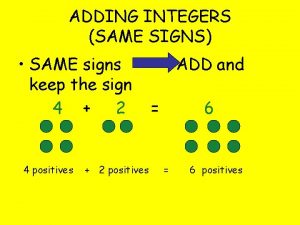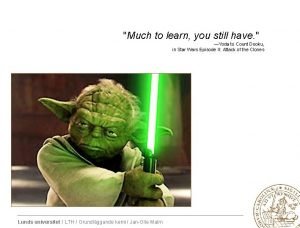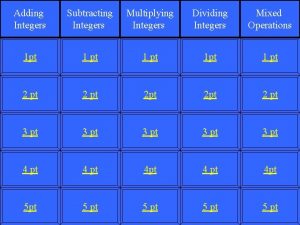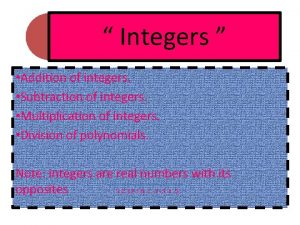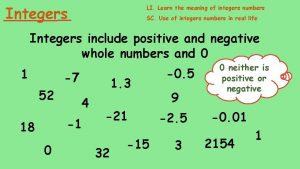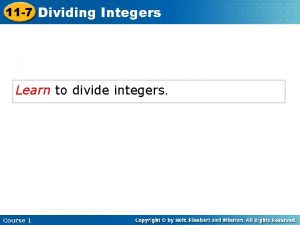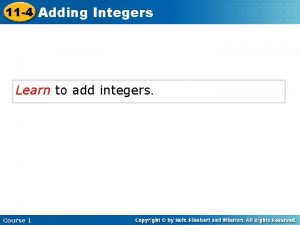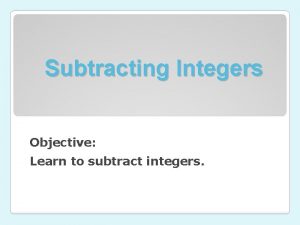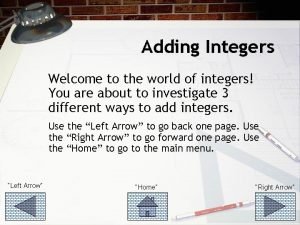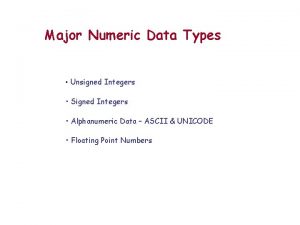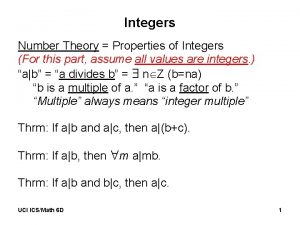Grade 8 Integers What You Will Learn n




























- Slides: 28

Grade 8 Integers!

What You Will Learn n n Some definitions related to integers. Rules for multiplying and dividing integers. Are you ready? ?

Definition n Positive number = a number greater than zero. 0 1 2 3 4 5 6

Definition n Negative number = a number less than zero. -6 -5 -4 -3 -2 -1 0 1 2 3 4 5 6

Definition n Opposite Numbers = numbers that are the same distance from zero in the opposite direction -6 -5 -4 -3 -2 -1 0 1 2 3 4 5 6

Definition n Integers = Integers are all the whole numbers and all of their opposites on the negative number line including zero. 7 opposite -7

Definition n Absolute Value = The size of a number with or without the negative sign. The absolute value of 9 or of – 9 = 9.

Negative Numbers Are Used to Measure Temperature

Negative Numbers Are Used to Measure Above and Below Sea Level 30 20 10 0 -10 -20 -30 -40 -50

Negative Numbers Are Used to Show Debt Let’s say your parents bought a car but had to get a loan from the bank for $5, 000. When counting all their money they add in -$5, 000 to show they still owe the bank.

Hint n If you don’t see a negative or positive sign in front of a number it is positive. 9 = +9

Integer Multiplication Rules n Rule #1 – If the signs are the same, pretend the signs aren’t there. Multiply the numbers and then put a positive sign in front of your answer. 9 x 5 = +45 (-9) x (-5) = +45

Solve the Problems -3 x -5 = n 4 x 7 = n (+3) x (+4) = n -6 x -7 = n 5 x 9 = n -9 x -9 = n

Answers -3 x -5 = +15 +28 n 4 x 7 = n (+3) x (+4) = +12 n -6 x -7 = +42 n 5 x 9 = +45 n -9 x -9 = +81 n

Integer Multiplication Rules n Rule #2 – If the signs are different pretend the signs aren’t there. Multiply the numbers and put a negative sign in front of your answer. -9 x 5 = -45

Solve These Problems 3 x -5 = n -4 x 7 = n (+3) x (-4) = n -6 x 7 = n 5 x -9 = n -9 x 9 = n

Answers 3 x -5 = -15 n -4 x 7 = -28 n (+3) x (-4) = -12 n -6 x 7 = -42 n 5 x -9 = -45 n -9 x 9 = -81 n

One Way to Multiply Integers Is With a Number Line When the signs are the same, count to the right. When the signs are opposite, count to the left. 2 x 3=6 + -6 -5 -4 -3 -2 -1 0 1 2 3 4 5 6

One Way to Multiply Integers Is With a Number Line (+3) x (-2) = -6 -6 -5 -4 -3 -2 -1 0 1 2 3 4 5 6

What about dividing with integers?

Integer Division Rule Dividing by a negative number is the same as multiplying by a negative number. Same signs result in a positive answer and different signs result in a negative answer. 14 ÷ (-7) is the same as -14 ÷ (+7) = -2

Here are some more examples. 16 ÷ (-8)= -2 -33 ÷ (-11)= 3 16 ÷ (+8)= 2 -33 ÷ (+11)= -3

How do we know that “A negative times (or divided by) a negative equals a positive” is true? The following slides show two ways to think about it…

Think about grammar! Some people think of a negative as meaning “not”. So if I say I’m not going to the store, doesn’t that mean I AM going to the store? (two negatives results in a positive answer? )

Think about patterns: 4 3 2 1 0 x x x 5 5 5 = = = 20 15 10 5 0 Both numbers are going down!

What about this pattern? : 4 x -5 = -20 3 x -5 = -15 2 x -5 = -10 1 x -5 = -5 0 x -5 = 0 The left numbers are going down and the right #s are going up!

But if we continue that pattern: 3 x -5 = -15 2 x -5 = -10 1 x -5 = -5 0 x -5 = 0 -1 x -5 = 5 -2 x -5 = 10 -3 x -5 = 15 -4 x -5 = 20 The left #s are still going down & the right #s are still going up! (Neg x neg = positive)

You have learned lots of things about multiplying and dividing integers. Review what you think you know with a partner!
 Kinesthetic learning
Kinesthetic learning The more you study the more you learn
The more you study the more you learn You live and you learn
You live and you learn Getting nerdy llc
Getting nerdy llc Grade 8 integers
Grade 8 integers Learn xtra grade 10
Learn xtra grade 10 Integer rules
Integer rules Same signs add
Same signs add Ordering integers examples
Ordering integers examples Much to learn yoda
Much to learn yoda My reason for joining extension work activities. *
My reason for joining extension work activities. * What are the five philosophies we can learn from the ants
What are the five philosophies we can learn from the ants Always obey your teacher
Always obey your teacher Passive voice would
Passive voice would You tell me and i forget
You tell me and i forget What do you expect to learn
What do you expect to learn French fries countable or uncountable
French fries countable or uncountable Pakikipagkilala
Pakikipagkilala Presen tsimple
Presen tsimple Rain
Rain You are what you eat do you agree or disagree
You are what you eat do you agree or disagree If you think you can you can poem
If you think you can you can poem Tell me what you eat and i shall tell you what you are
Tell me what you eat and i shall tell you what you are Follow you wherever you go
Follow you wherever you go Raw grade to transmuted
Raw grade to transmuted Jump rope rhymes
Jump rope rhymes Difference between grade a and grade aa eggs
Difference between grade a and grade aa eggs Milk grades
Milk grades Grading of grapes
Grading of grapes







